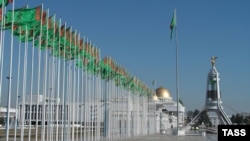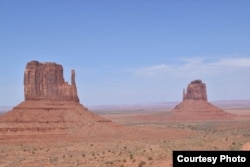
The 12th of December is a holiday in Turkmenistan known as Neutrality Day, with this year marking 25 years since the UN officially recognized the authoritarian Central Asian state as a neutral country.
Turkmen officials -- particularly President Gurbanguly Berdymukhammedov -- prefer these days to use the term "positive neutrality," and it is a big deal in Turkmenistan.
It is enshrined in the country's constitution, for example in Article 2, where is states: "The permanent neutrality of Turkmenistan shall be the basis of its national and foreign policy." And in Article 68, where it says: "The president of Turkmenistan shall be the head of the state and executive power, the highest official of Turkmenistan, acting as guarantor of...state independence and the status of permanent neutrality of Turkmenistan…"
There is also a 95-meter-high Arch of Neutrality in the capital, Ashgabat, built during the rule of first President Saparmurat Niyazov and topped with a golden statue of Niyazov that used to revolve so that it always faced the sun.
Niyazov even ordered the months of the year to be renamed and for December to be known as Bitaraplyk, which is neutrality in Turkmen.
Cursory Decision
But while the government loudly and repeatedly hails the UN decision to bestow the status of neutrality on Turkmenistan, it was not really an issue when the world body approved it.
The official record from the UN General Assembly's 50th session (and 90th plenary meeting) on December 12, 1995, shows there were 81 items on the agenda, including disarmament agreements, bans on certain nuclear-weapons tests, and a prohibition on the development, production, and stockpiling of biological weapons.
The latter topic on biological weapons was agenda item 80 that day, followed by the last item, Turkmenistan's request to be recognized as a neutral country.
The text, read by the General Assembly's president, basically went like this: "The Assembly will now take a decision on the two draft resolutions (the second was the development of good-neighborly relations among Balkan States)." It continued: "Draft resolution A [on neutrality] was adopted by the First Committee without a vote. May I consider that the assembly wishes to do likewise? Draft resolution A was adopted [with 50 of the 80 countries in attendance agreeing to it]."
That is all.
And for the last 25 years that cursory decision on neutrality has been a centerpiece of Turkmenistan's policies, both domestic and foreign.
So what does that actually mean?
It is difficult to say, but the short answer is, not much.
Niyazov envisioned neutrality as, among other things, making Turkmenistan a neutral venue for feuding parties to come and work out their differences.
In the first five years of its neutrality, that was true as Turkmenistan hosted talks between warring parties from the Tajik and Afghan civil wars.
But it has been 20 years since anyone took Turkmenistan up on its offer of providing a place to share "the pilaf of peace," as Niyazov once said.
Turkmen officials have issued the invitation several times, most recently suggesting Afghan peace talks -- currently being held in Doha -- could be held there.
Cocooned And Isolated
The Turkmen government has used neutrality to avoid joining multilateral organizations, particularly security organizations, and at the same time has practically shut off Turkmenistan from the outside world.
The leadership in Ashgabat has basked in splendid isolation while the country's population has been cocooned, receiving only scant information about world affairs and continually being presented with a sanitized and overly optimistic view of domestic affairs even when they can easily see the falsehood of the wonderland presented on state media.
Neutrality has not shielded Turkmenistan from real life and the reality now -- as Turkmenistan prepares to mark the 25th anniversary of the UN neutrality designation -- is that the country's economy is in the worst shape it has ever been in since gaining independence in 1991.
There are constant food shortages, not enough cash, and the country is facing the worst health crisis in its short history due the spread of the coronavirus while the government shockingly continues to deny that there has been a single case in the country of the pandemic that is ravaging the world.
Turkmenistan's border with Afghanistan is no longer secure, with some reports claiming that up to dozens of Turkmen soldiers have died in recent years in shoot-outs with militants operating in northern Afghanistan.
The militants, being nonstate actors, have no respect for Turkmenistan's status as a neutral country and, according to some reports, have attacked and killed Turkmen troops to seize their weapons.
And there is no sign that any of these problems will be alleviated anytime soon. In fact, they will likely worsen in the coming weeks and months -- with "positive neutrality" leaving Turkmenistan without any strong allies that could help it in its time of need.
It is difficult after a quarter of a century to see a single way in which Turkmenistan and its people have benefited from neutrality.














